| dc.contributor.author | Akbilgiç, Oğuz | |
| dc.contributor.author | Obi, Yoshitsugu | |
| dc.contributor.author | Potukuchi, Praveen K. | |
| dc.contributor.author | Karabayır, İbrahim | |
| dc.contributor.author | Nguyen, Danh, V | |
| dc.contributor.author | Soohoo, Melissa | |
| dc.contributor.author | Kovesdy, Csaba P. | |
| dc.date.accessioned | 2021-12-12T17:00:48Z | |
| dc.date.available | 2021-12-12T17:00:48Z | |
| dc.date.issued | 2019 | |
| dc.identifier.issn | 2468-0249 | |
| dc.identifier.uri | https://doi.org/10.1016/j.ekir.2019.06.009 | |
| dc.identifier.uri | https://hdl.handle.net/20.500.11857/2920 | |
| dc.description.abstract | Introduction: Given the high mortality rate within the first year of dialysis initiation, an accurate estimation of postdialysis mortality could help patients and clinicians in decision making about initiation of dialysis. We aimed to use machine learning (ML) by incorporating complex information from electronic health records to predict patients at risk for postdialysis short-term mortality. Methods: This study was carried out on a contemporary cohort of 27,615 US veterans with incident end-stage renal disease (ESRD). We implemented a random forest method on 49 variables obtained before dialysis transition to predict outcomes of 30-, 90-, 180-, and 365-day all-cause mortality after dialysis initiation. Results: The mean (+/- SD) age of our cohort was 68.7 +/- 11.2 years, 98.1% of patients were men, 29.4% were African American, and 71.4% were diabetic. The final random forest model provided C-statistics (95% confidence intervals) of 0.7185 (0.6994-0.7377), 0.7446 (0.7346-0.7546), 0.7504 (0.7425-0.7583), and 0.7488 (0.7421-0.7554) for predicting risk of death within the 4 different time windows. The models showed good internal validity and replicated well in patients with various demographic and clinical characteristics and provided similar or better performance compared with other ML algorithms. Results may not be generalizable to non-veterans. Use of predictors available in electronic medical records has limited the assessment of number of predictors. Conclusion: We implemented and ML-based method to accurately predict short-term postdialysis mortality in patients with incident ESRD. Our models could aid patients and clinicians in better decision making about the best course of action in patients approaching ESRD. | en_US |
| dc.description.sponsorship | National Institutes of HealthUnited States Department of Health & Human ServicesNational Institutes of Health (NIH) - USA [U01-DK102163]; VA Information Resource Center [SDR 02-237, SDR 98-004]; NATIONAL INSTITUTE OF DIABETES AND DIGESTIVE AND KIDNEY DISEASESUnited States Department of Health & Human ServicesNational Institutes of Health (NIH) - USANIH National Institute of Diabetes & Digestive & Kidney Diseases (NIDDK) [U01DK102163] Funding Source: NIH RePORTER | en_US |
| dc.description.sponsorship | This study is supported by grant U01-DK102163 from the National Institutes of Health to KKZ and CK and by resources from the US Department of Veterans Affairs (VA). The data reported here have been supplied in part by the US Renal Data System (USRDS). Support for VA/Centers for Medicare and Medicaid Services (CMS) data is provided by the Veterans Health Administration, Office of Research and Development, Health Services Research and Development, and VA Information Resource Center (project numbers SDR 02-237 and 98-004). | en_US |
| dc.language.iso | eng | en_US |
| dc.publisher | Elsevier Science Inc | en_US |
| dc.relation.ispartof | Kidney International Reports | en_US |
| dc.identifier.doi | 10.1016/j.ekir.2019.06.009 | |
| dc.rights | info:eu-repo/semantics/openAccess | en_US |
| dc.subject | chronic kidney disease | en_US |
| dc.subject | dialysis | en_US |
| dc.subject | end-stage renal disease | en_US |
| dc.subject | mortality | en_US |
| dc.subject | random forest | en_US |
| dc.title | Machine Learning to Identify Dialysis Patients at High Death Risk | en_US |
| dc.type | article | |
| dc.authorid | akbilgic, oguz/0000-0003-0313-9254 | |
| dc.authorid | Obi, Yoshitsugu/0000-0001-7032-4383 | |
| dc.authorid | Kalantar-Zadeh, Kamyar/0000-0002-8666-0725 | |
| dc.authorid | Karabayir, Ibrahim/0000-0002-7928-176X | |
| dc.department | Fakülteler, İktisadi ve İdari Bilimler Fakültesi, Ekonometri Bölümü | |
| dc.identifier.volume | 4 | en_US |
| dc.identifier.startpage | 1219 | en_US |
| dc.identifier.issue | 9 | en_US |
| dc.identifier.endpage | 1229 | en_US |
| dc.relation.publicationcategory | Makale - Uluslararası Hakemli Dergi - Kurum Öğretim Elemanı | en_US |
| dc.authorscopusid | 28567583700 | |
| dc.authorscopusid | 23989021400 | |
| dc.authorscopusid | 57144489700 | |
| dc.authorscopusid | 56677890800 | |
| dc.authorscopusid | 7402147259 | |
| dc.authorscopusid | 56083494400 | |
| dc.authorscopusid | 6507712607 | |
| dc.identifier.wos | WOS:000484384000004 | en_US |
| dc.identifier.scopus | 2-s2.0-85070215161 | en_US |
| dc.identifier.pmid | PubMed: 31517141 | en_US |
| dc.authorwosid | akbilgic, oguz/F-9407-2013 | |
| dc.authorwosid | Obi, Yoshitsugu/G-5764-2017 | |
| dc.authorwosid | Kalantar-Zadeh, Kamyar/Q-4734-2018 | |
| dc.authorwosid | Karabayir, Ibrahim/AAC-3262-2019 | |



















